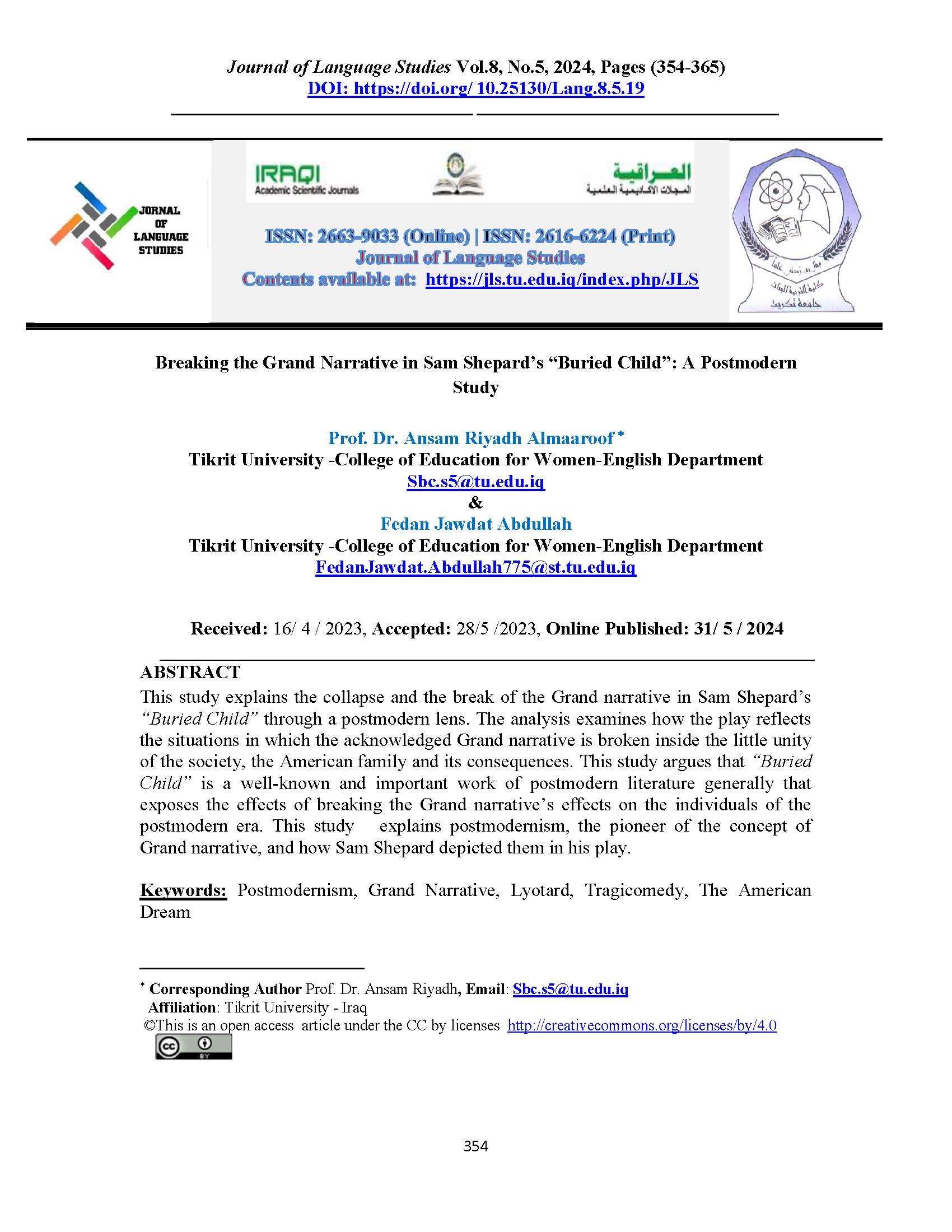Breaking the Grand Narrative in Sam Shepard’s “Buried Child”: A Postmodern Study
DOI:
https://doi.org/10.25130/Lang.8.5.19Keywords:
Postmodernism, Grand Narrative, Lyotard, Tragicomedy, he American DreamAbstract
This study explains the collapse and the break of the Grand narrative in Sam Shepard’s “Buried Child” through a postmodern lens. The analysis examines how the play reflects the situations in which the acknowledged Grand narrative is broken inside the little unity of the society, the American family and its consequences. This study argues that “Buried Child” is a well-known and important work of postmodern literature generally that exposes the effects of breaking the Grand narrative’s effects on the individuals of the postmodern era. This study explains postmodernism, the pioneer of the concept of Grand narrative, and how Sam Shepard depicted them in his play.
References
Al-Maaroof, A. R. (2017). A Post-structural Reading of Sam Shepard's "Buried Child". Al-Adab Journal, Language, Literature and Culture in Contact, (Volume), 79-86.
Al-Maaroof, A. R. (2024). The Differences in handling Identity Concept between Modern and Postmodern Perspectives in Literary Texts. A lecture in MA course in English Literature- Postmodernism. At: https://scholar.google.com/citations?view_op=view_citation&hl=en&user=rw_T_LEAAAAJ&citation_for_view=rw_T_LEAAAAJ:xtRiw3GOFMkC
Butler, J. (1990). Gender trouble: Feminism and the subversion of identity. Routledge.
Elliott, M. (2013). Sam Shepard and the American theatre. Cambridge University Press.
Foucault, M. (1972). The archaeology of knowledge. Pantheon.
Gussow, M. (2017, July 31). Sam Shepard, the Pulitzer-winning playwright and actor, is dead at 73. The New York Times. https://www.nytimes.com/2017/07/31/theater/sam-shepard-dead-playwright.html
Halberstam, D. (1998). Skin shows Gothic horror and the technology of monsters. Duke University Press.
Haraway, D. (1985). A Manifesto for Cyborgs: Science, technology, and socialist feminism in the 1980s. Socialist Review, 80, 65–108.
Hassan, I. (1987). The postmodern turn: Essays in postmodern theory and culture. Ohio University Press.
Henderson, B. (2007). Understanding Sam Shepard. University of South Carolina Press.
Hutcheon, L. (1988). A poetics of postmodernism: History, theory, fiction. Routledge.
Hutcheon, L. (2002). The politics of postmodernism (2nd ed.). Routledge.
Jameson, F. (1984). Postmodernism, or the cultural logic of late capitalism. New Left Review, 146, 53–92.
Kennedy, D. M. (Ed.). (2012). Sam Shepard: A casebook. Routledge.
Kolocotroni, V., Goldman, J., & Taxidou, O. (1998). Modernism: An anthology of sources and documents. University of Chicago Press.
Kristeva, J. (1966). Word, dialogue, and novel. Diacritics, 1(2), 27-38.
Lyotard, J.-F. (1984). The postmodern condition: A report on knowledge. The University of Minnesota Press.
Sandoval-Sánchez, A. (2012). The theatre of Sam Shepard: States of Crisis. Routledge.
Shepard, S. (1978). Buried Child. New York, NY: Samuel French, Inc.
Shepard, Sam. "Buried Child." The Review of Contemporary Fiction, vol. 5, no. 3, 1985, p. 116.
Shepard, S. (1996). Buried Child. Vintage Books.
Shepard, S. (2010). Fool for love and other plays. Grove Press.

